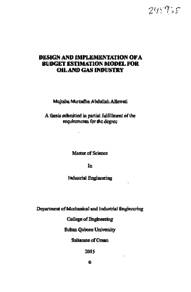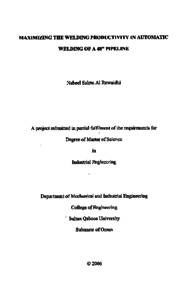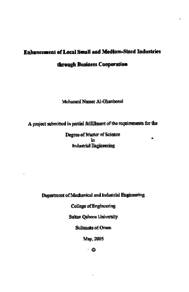وثيقة
Design and implementation of a budget estimation model for oil and gas industry
الناشر
Sultan Qaboos University
ميلادي
2015
اللغة
الأنجليزية
الملخص الإنجليزي
In some countries, oil and gas industry accounts as a key factor that influencing the gross domestic product (GDP). Therefore, this industry has gained high attentions. Nevertheless, this industry is surrounded with high level of uncertainties especially regarding well explorations and cost estimates of drilling wells. This work describes a framework toward building a model for budget estimations for drilling wells. The current approach that is utilized by most of the companies is only depending on one single scenario, which is known as the deterministic approaches. This approach is associated with high level of uncertainties regarding the estimates of time and cost for drilling a well. On the other hand, another method known as the probabilistic approaches is considering multiple scenarios that are based on the nature of the data.
The current method that was used by the company was producing one single value for the cost and time necessary to drill well. The six sigma DMAIC methodology was utilized to explain the uncertainties associated with the current estimates of drilling wells. The methodology utilized the historical data available for specific lls to understand the nature of the problem that was facing the company. An analysis was performed to cover all the possible factors that can cause variation in the cost and time associated with drilling wells. In addition the analysis utilized risk analysis and Monte Carlo simulation integrated with the statistical analysis of the historical data. Four different statistical models have been applied toward improving the current estimates. These models provided new estimates for the cost and time needed to drill wells. These new estimates were compared with the actual data in order to validate the performance of these models. This comparison was based on four indicators. The best results for the estimates obtained that the new estimates were able to predict the actual ones by 85% for the cost and by 75.5% for the duration.
المجموعة
URL المصدر
الملخص العربي
في بعض البلدان، يمثل قطاع صناعة النفط والغاز عاملا أساسيا في التأثير على الناتج المحلي الإجمالي (GDP). نتيجة لذلك اكتسب هذا القطاع اهمية عالية. ومع ذلك، يحيط بهذه الصناعة مستوى عال من الشكوك وعدم اليقين خاصة فيما يتعلق بالاستكشافات الجديدة وتقدير التكلفة لازمة لحفر الآبار .
يصف هذا العمل إطارا نحو بناء نموذج لتقدير الميزانية لازمة لحفر الآبار النهج الحالي المتبع من قبل معظم الشركات يعتمد فقط على سيناريو واحد، والذي يعرف باسم النهجية الحتمية. يرتبط هذا النهج مع مستوى عال من عدم اليقين بشان تقديرات الوقت والتكلفة اللازمين لحفر الآبار. من ناحية أخرى، توجد طريقة أخرى تعرف باسم النهجية الاحتمالية والتي تعتمد على ايجاد سيناريوهات متعددة والتي تستند بشكل مباشر على طبيعة البيانات.
الأسلوب الحالي المتبع والذي يتم استخدامه من قبل الشركة يتنج قيمة واحدة فقط للتكلفة والوقت الازم لحفر بئر نفطي. تم استخدام منهجية DMAIC ستة سيغما لشرح نقاط علم اليقين المرتبطة بالتقديرات الحالية لحفر الآبار المنهجية المستخدمة تعتمد على البيانات المتاحة لمجموعة من الآبار لفهم طبيعة المشكلة التي تواجه الشركة. كما تم أيضا إجراء تحليلات لتغطية جميع العوامل التي يمكن أن تسبب التباين في التكلفة والوقت الازم لحفر الآبار. وبالإضافة إلى تلك التحليلات تم اعتماد منهجية تحليل المخاطر ومحاكاه مونتي كارلو مع التحليل الإحصائي. تم تطبيق اربعة نماذج إحصائية مختلفة من أجل تحسين التقديرات الحالية. قدمت هذه النماذج تقديرات جديدة للتكاليف والوقت اللازم لحفر الآبار. تمت مقارنة هذه التقديرات الجديدة مع البيانات الفعلية من أجل التحقق من صحة أداء هذه النماذج استندت هذه المقارنة على أربعة مؤشرات. كانت أفضل النتائج إلى أن التقديرات الجديدة كانت قادرة على التنبؤ بنسبة 85٪ للتكاليف المتعلقة بحفر الآبار وبنسبة % 75 . 5 للوقت الازم لحفر الآبار.
يصف هذا العمل إطارا نحو بناء نموذج لتقدير الميزانية لازمة لحفر الآبار النهج الحالي المتبع من قبل معظم الشركات يعتمد فقط على سيناريو واحد، والذي يعرف باسم النهجية الحتمية. يرتبط هذا النهج مع مستوى عال من عدم اليقين بشان تقديرات الوقت والتكلفة اللازمين لحفر الآبار. من ناحية أخرى، توجد طريقة أخرى تعرف باسم النهجية الاحتمالية والتي تعتمد على ايجاد سيناريوهات متعددة والتي تستند بشكل مباشر على طبيعة البيانات.
الأسلوب الحالي المتبع والذي يتم استخدامه من قبل الشركة يتنج قيمة واحدة فقط للتكلفة والوقت الازم لحفر بئر نفطي. تم استخدام منهجية DMAIC ستة سيغما لشرح نقاط علم اليقين المرتبطة بالتقديرات الحالية لحفر الآبار المنهجية المستخدمة تعتمد على البيانات المتاحة لمجموعة من الآبار لفهم طبيعة المشكلة التي تواجه الشركة. كما تم أيضا إجراء تحليلات لتغطية جميع العوامل التي يمكن أن تسبب التباين في التكلفة والوقت الازم لحفر الآبار. وبالإضافة إلى تلك التحليلات تم اعتماد منهجية تحليل المخاطر ومحاكاه مونتي كارلو مع التحليل الإحصائي. تم تطبيق اربعة نماذج إحصائية مختلفة من أجل تحسين التقديرات الحالية. قدمت هذه النماذج تقديرات جديدة للتكاليف والوقت اللازم لحفر الآبار. تمت مقارنة هذه التقديرات الجديدة مع البيانات الفعلية من أجل التحقق من صحة أداء هذه النماذج استندت هذه المقارنة على أربعة مؤشرات. كانت أفضل النتائج إلى أن التقديرات الجديدة كانت قادرة على التنبؤ بنسبة 85٪ للتكاليف المتعلقة بحفر الآبار وبنسبة % 75 . 5 للوقت الازم لحفر الآبار.
قالب العنصر
الرسائل والأطروحات الجامعية



